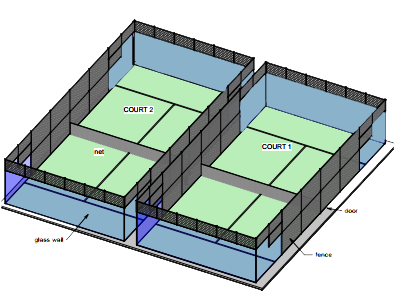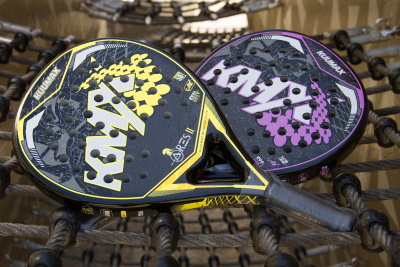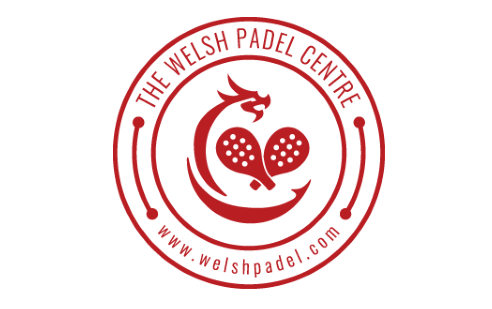A Hybrid of Tennis and Squash
Neither tennis nor squash - but elements of both!
Padel Tennis is a racket sport played in a glass and mesh enclosure which has elements of both tennis and squash. It is a doubles game played across a 'tennis' net with the same scoring as tennis. However, like squash, the ball may be played off the glass walls and, with difficulty, off the mesh walls. Therefore there are elements of both tennis and squash in the game.
The Courts and Equipment

The above representation of two padel courts shows the 3m back and side glass walls topped by 1m mesh panel. In most courts the glass side walls step down until they become fully mesh walls near the net. Side doors adjacent to the net provide access. The padel court surface is an artificial polymer grass type surface with a net height slightly lower than a tennis court. Padel balls look the same as tennis balls but are less pressurised and therefore less bouncy. Courts are 20m x 10m which makes them about twice the length of a squash court and 40% wider. Alternatively, you can think of them as about a third the size of a tennis court.

Padel rackets are made from either fibreglass (lower cost) or carbon fibre. Each racket has a wrist band for safety. They cost from circa £50 upwards.
The Advantages of Padel
The serve in padel is underarm and therefore, if you struggle with serving in tennis, it's a lot easier to get proficient. Also, the strength of a serve is less of a differentiator as padel is a game of skill rather than strength. If you hit the ball too hard it simply bounces off the wall leaving your opponent with an easy return!
The fact that the court is contained and the ball very rarely leaves the court gives padel two key advantages over tennis: (i) rallies last longer and therefore your exercise level is higher, and (ii) you are not constantly chasing balls all over the court so there is less time wasted between points. In short, the ball is in play for longer!
As mentioned, padel is a game of skill rather than strength so it is common for men and women to play together and it is suitable for all age groups. While it is easier than tennis to get started, don't be fooled - it is said that padel is easy to learn and difficult to master.
What Makes it Hard?
Tennis players will be immediately at home on a padel court. The balls look familiar, they are standing across the net from their oponents, serving is broadly the same (underarm only) and the scoring is the same. What is not to like? It's those pesky walls. Tennis players find the walls get in the way of their backswing and have to adapt to thinking of the wall as a friend not an enemy. There are two other key adaptions tennis players need to make: (i) those who play a power game will find it ineffective; and (ii) those who rely on spin will find that it's harder to put a spin on the ball with the flat surface of a padel racket!
Squash players will be immediately comfortable playing off and using the walls but will not be familiar with anything else. They are not used to playing doubles or playing across the court from their opponents. The ball is bouncier and the rackets shorter.
Padel is generally accepted to be a faster game than tennis but a slower game than squash.
Fastest Growing Racket Sport in the World
Padel originated in it's current form in Mexico and is popular throughout Latin America (especially Argentina) and Spain. It is the second largest participation sport in Spain (the first is football/soccer) with an estimated 20,000 courts catering for the ~4 million active players. The sport is growing rapidly throughout mainland Europe with an estimated eight-fold growth in courts over the last five years.
In the UK various British companies are making a passionate effort to establish the padel, helped by the sport being brought under the wing of the LTA (Lawn Tennis Association) in 2019. The LTA has published a padel development plan, outlining its ambition to grow the sport. With an initial focus placed on increasing infrastructure the governing body estimates a total of 400 padel courts will be in place by 2023. Read the Plan (opens in a new tab)
Visit YouTube and watch some padel videos: Click Here (opens in a new tab); or watch the BBC Children in Need Ultimate (Padel) Tennis Showndown with Peter Crouch and Andy Murray on YouTube: Click Here (opens in a new tab)
